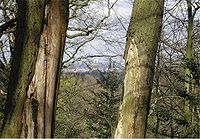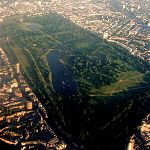- Dulwich Wood
-
Dulwich Wood 
A view from Dulwich Wood in the early spring, with Battersea Power Station in the distance.Type Woodland Location Dulwich Coordinates 51°26′07″N 0°04′27″W / 51.435149°N 0.074028°W Operated by Dulwich Estate Dulwich Wood together with the adjacent Sydenham Hill Wood is the largest extant part[1] of the ancient Great North Wood.[2] The two woods were separated after the relocation of The Crystal Palace in 1854 and the creation of the high level line in 1865.[3] The wood is privately owned[4] and managed by the Dulwich Estate.[3]
Contents
History
In the Middle Ages the Manor of Dulwich belonged to Bermondsey Abbey, having been given to the abbey in in 1127 by King Henry I.[5] When Henry VIII dissolved the monasteries in 1542 he had the Dulwich Estate surveyed.
The Court of King Charles I, paid frequent visits to Dulwich and its woods to hunt deer.[6]
By 1605 Edward Alleyn was a wealthy man and for £5,000 (a large amount in those days), was able to buy the Manor of Dulwich from the Calton family, who had owned it since the dissolution of the monasteries. Alleyn managed the woods in a business-like way, dividing them into ten coppices, one coppice to be felled each year when the trees were ten years old. Peckarman's Wood, now a housing estate, was one of these coppices.[5]
In 1738 a man named Samuel Bentyman was murdered in Dulwich Wood.[6] In 1803 Samuel Matthews, known as the Dulwich Hermit, met with a similar fate.[6][7] The grave of Samuel Matthews is in Dulwich Old Cemetery in the heart of Dulwich Village.[8]
Access
The wood can be reached from Sydenham Hill railway station. From the station turn right a short distance along College Road, past St Stephen's church, then through the white gate on the opposite side of the road into Low Cross Wood Lane and on the left just ahead is a gate to Dulwich Wood. There is also an entrance by the footbridge on Cox's Walk, off Dulwich Common.
References
- ^ The Great North Wood — A brief history of ancient woodlands from Selhurst to Deptford by LSC Neville, London Wildlife Trust, 1987
- ^ London Wildlife Trust about Sydenham Hill Wood & Cox's Walk
- ^ a b Based on post by local historian Steve Grindlay to Sydenham Town Forum Topic: Old Sydenham Hill
- ^ london-footprints.co.uk
- ^ a b The Story of Dulwich by Mary Boast, 1990, London Borough of Southwark
- ^ a b c Peckham and Dulwich, Old and New London: Volume 6 (1878), pp. 286-303.
- ^ Brighton & Hove Museum's Rogues' Gallery
- ^ Historic sites in Southwark given English Heritage funding
External links
- Dulwich and Sydenham Hill Woods on London Wildweb
- London Wildlife Trust website
Parks and open spaces by London borough Barking and Dagenham · Barnet · Bexley · Brent · Bromley · Camden · Croydon · Ealing · Enfield · Greenwich · Hackney · Hammersmith and Fulham · Haringey · Harrow · Havering · Hillingdon · Hounslow · Islington · Kensington and Chelsea · Kingston · Lambeth · Lewisham · Merton · Newham · Redbridge · Richmond · Southwark · Sutton · Tower Hamlets · Waltham Forest · Wandsworth · Westminster
Categories:- Ancient woods of London
- Parks and open spaces in Southwark
- Conservation in the United Kingdom
- Nature reserves in London
- Walking in London
- Woodland in London
- Dulwich
Wikimedia Foundation. 2010.

